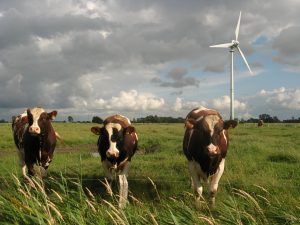16 May 2016
WASHINGTON, DC — Emissions from farms outweigh all other human sources of fine-particulate air pollution in much of the United States, Europe, Russia and China, according to new research. The culprit: fumes from nitrogen-rich fertilizers and animal waste combine in the air with combustion emissions to form solid particles, which constitute a major source of disease and death, according to the new study.

Fumes from nitrogen-rich fertilizers and animal waste combine in the air with combustion emissions to form solid particles in the air. These aerosols outweigh all other human sources of fine-particulate air pollution in much of the United States, Europe, Russia and China, according to new research.
Credit: Dirk Ingo Franke via Wikimedia Commons.
The good news is if combustion emissions decline in coming decades, as most projections say, fine-particle pollution will go down even if fertilizer use doubles as expected, according to the new study published in Geophysical Research Letters, a journal of the American Geophysical Union.
Agricultural air pollution comes mainly in the form of ammonia, which enters the air as a gas from heavily fertilized fields and livestock waste. It then combines with pollutants from combustion—mainly nitrogen oxides and sulfates from vehicles, power plants and industrial processes—to create tiny solid particles, or aerosols, no more than 2.5 micrometers across, about 1/30 the width of a human hair.
Aerosols can penetrate deep into lungs, causing heart or pulmonary disease. A 2015 study in the journal Nature estimates they cause at least 3.3 million deaths each year globally, and a recent study in Geophysical Research Letters found they cause over 500,000 annual deaths in India alone.
Many regional studies, especially in the United States, have shown agricultural pollution to be a prime source of fine-particulate precursors, but the new study is one of the first to look at the phenomenon worldwide and to project future trends. The study’s results show more than half the aerosols in much of the eastern and central United States come from farming.
“This is not against fertilizer—there are many places, including Africa, that need more of it,” said Susanne Bauer, an atmospheric scientist at Columbia University’s Center for Climate Systems Research and NASA’s Goddard Institute for Space Studies in New York and lead author of the study. “We expect population to go up, and to produce more food, we will need more fertilizer.”
The fact that agricultural emissions must combine with other pollutants to make aerosols is good news, according to Bauer. Most projections say tighter regulations, cleaner sources of electricity and higher-mileage vehicles will cut industrial emissions enough by the end of this century that farm emissions will be starved of the other ingredients necessary to create aerosols, she said.
“You might expect air quality would decline if ammonia emissions go up, but this shows it won’t happen, provided the emissions from combustion go down,” said Fabien Paulot, an atmospheric chemist with Princeton University and the National Oceanic and Atmospheric Administration who was not involved in the study. That means pollutants other than ammonia should probably be targeted for abatement, he said.
Johannes Lelieveld, lead author of the 2015 Nature study, disagreed. “One should be cautious about suggesting that food production could be increased” without increasing pollution, because that “critically depends” on the assumption that societies will successfully curb industrial emissions, he said. Lelieveld pointed out that even with recent reductions in industrial pollution, most nations, including the United States, still have large areas that exceed the World Meteorological Organization’s recommended maximum of particulate matter.
If future industrial emissions do go down, much farm-produced ammonia will end up in Earth’s troposphere, roughly 2 to 10 kilometers (1 to 6 miles) above the surface, Bauer said. There, lightning and other natural processes may also help create fine particulates, but most of these particles would be trapped by raindrops and harmlessly removed from the atmosphere, she said.
###
The American Geophysical Union is dedicated to advancing the Earth and space sciences for the benefit of humanity through its scholarly publications, conferences, and outreach programs. AGU is a not-for-profit, professional, scientific organization representing more than 60,000 members in 139 countries. Join the conversation on Facebook, Twitter, YouTube, and our other social media channels.
Notes for Journalists
This research article will be open access for 30 days from the date of publication. A PDF copy of the article can be downloaded at the following link: http://onlinelibrary.wiley.com/doi/10.1002/2016GL068354/abstract
After 30 days, journalists and public information officers (PIOs) of educational and scientific institutions who have registered with AGU can download a PDF copy of the article from the same link.
Journalists and PIOs who have not registered with AGU may order a copy of the final paper by emailing a request to Lauren Lipuma at [email protected].
Please provide your name, the name of your publication, and your phone number.
Neither the paper nor this press release is under embargo.
“Significant Atmospheric Aerosol Pollution caused by World Food Cultivation”
Authors:
Susanne E. Bauer, Kostas Tsigaridis: The Earth Institute, Center for Climate Systems Research, Columbia University, and NASA Goddard Institute for Space Studies, New York, New York, U.S.A.;
Ron Miller: NASA Goddard Institute for Space Studies and Department of Applied Physics and Applied Mathematics and Department of Earth and Environmental Sciences, Columbia University, New York, New York, U.S.A.
Contact Information for the Authors:
Susanne Bauer: +1 (212) 678-5666, [email protected]
Lauren Lipuma
+1 (202) 777-7396
[email protected]